1. Bai Dinh Pagoda
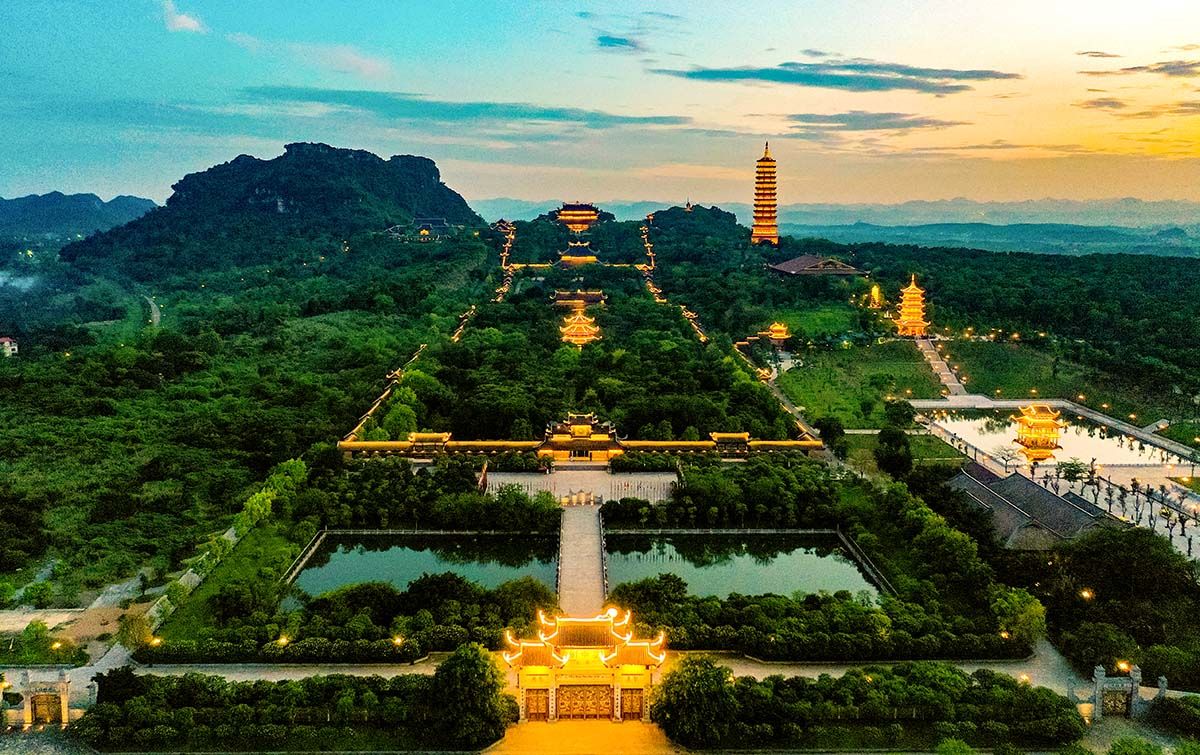
Address: Gia Sinh Commune, Gia Vien District, Ninh Binh Province
Bai Dinh Pagoda, part of the Trang An scenic complex, is one of the most prominent spiritual tourist destinations in Ninh Binh today. With its massive scale and architecture bearing the mark of Buddhism, this place attracts millions of visitors from all over the world to worship and sightsee every year. When visiting, visitors can not only admire the record-breaking Buddha statue system and giant bell tower, but also feel the purity and sacredness in the middle of the majestic wild mountains and forests. This is an ideal destination for those who wish to find peace of mind, while exploring the unique cultural and spiritual depth of the ancient capital.
>>> See the latest Northern tours <<<
1. Hanoi - Ha Long - Yen Tu - Ninh Binh - Bai Dinh - Trang An
2. Hanoi - Ha Long - Sapa - Cat Cat Village - Fansipan - Free Muong Hoa mountain train ticket
3. Ha Giang - Lung Cu - Dong Van - Ma Pi Leng - Meo Vac - Cao Bang - Ban Gioc Waterfall - Ba Be Lake
2. Bich Dong Pagoda
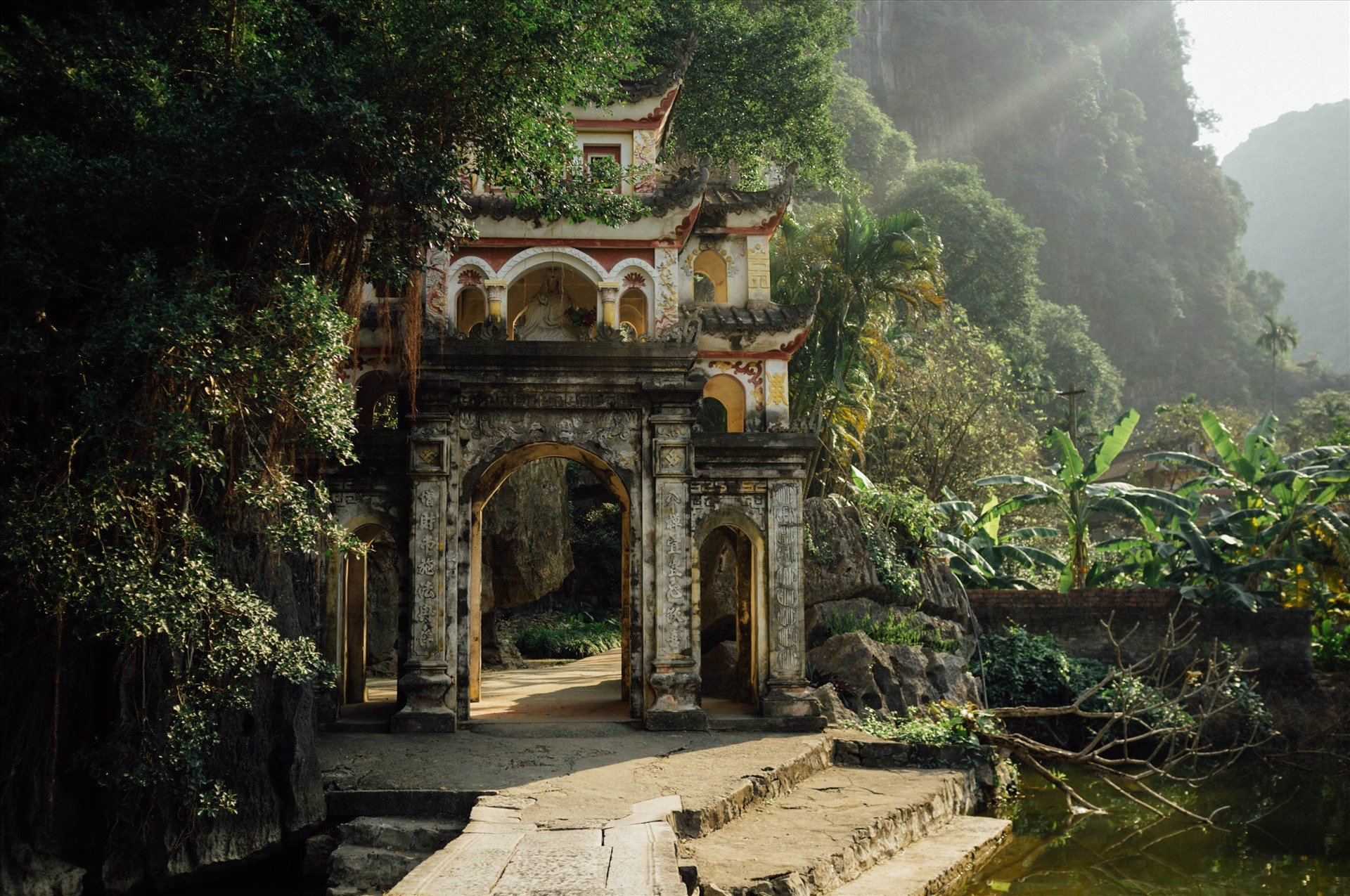
Address: Dam Khe Village, Ninh Hai Commune, Hoa Lu District, Ninh Binh Province
Located in the Tam Coc - Bich Dong scenic complex, Bich Dong Pagoda is an ancient Ninh Binh pagoda famous for its harmonious architecture between nature and people. Dubbed "Nam Thien De Nhi Dong", this place not only possesses beautiful scenery but is also a spiritual tourist destination in Ninh Binh that attracts a large number of tourists and Buddhists to worship and sightsee.
The pagoda was built during the Later Le Dynasty (1428), consisting of three separate parts: the Lower Pagoda, the Middle Pagoda and the Upper Pagoda, arranged according to the shape of the mountain, creating a quiet and sacred space. With its unique “Tam” architecture and the presence of a natural cave system, the pagoda is an ideal destination for those who want to explore spiritual relics associated with the beauty of traditional Buddhist culture.
3. Thien Ton Cave
Address: Thien Ton Town, Hoa Lu District, Ninh Binh Province
Known as one of the most prominent spiritual tourist destinations in Ninh Binh, Thien Ton Cave is located on Dung Duong mountain range, east of the ancient capital of Hoa Lu. Together with Thanh Nguyen Temple, Tran Temple and Cao Son Temple, this place forms the "Hoa Lu Tu Tran" - the spiritual protection system of the four directions of the ancient capital.
Inside the cave is the temple of Saint Tran Vu Thien Ton - the god guarding the North, symbolizing strength and protection. The bronze statue is placed majestically on the back of a sacred turtle, evoking a sense of sacredness and mystery. With its ancient beauty and profound cultural and spiritual values, this place is a must-see stop on your journey to explore Ninh Binh, especially for those who love spiritual tourism in Ninh Binh and learn about traditional festivals in Ninh Binh.
Known as one of the most prominent spiritual tourist destinations in Ninh Binh, Thien Ton Cave is located on Dung Duong mountain range, east of the ancient capital of Hoa Lu. Together with Thanh Nguyen Temple, Tran Temple and Cao Son Temple, this place forms the "Hoa Lu Tu Tran" - the spiritual protection system of the four directions of the ancient capital.
Inside the cave is the temple of Saint Tran Vu Thien Ton - the god guarding the North, symbolizing strength and protection. The bronze statue is placed majestically on the back of a sacred turtle, evoking a sense of sacredness and mystery. With its ancient beauty and profound cultural and spiritual values, this place is a must-see stop on your journey to explore Ninh Binh, especially for those who love spiritual tourism in Ninh Binh and learn about traditional festivals in Ninh Binh.
4. Thai Vi Temple
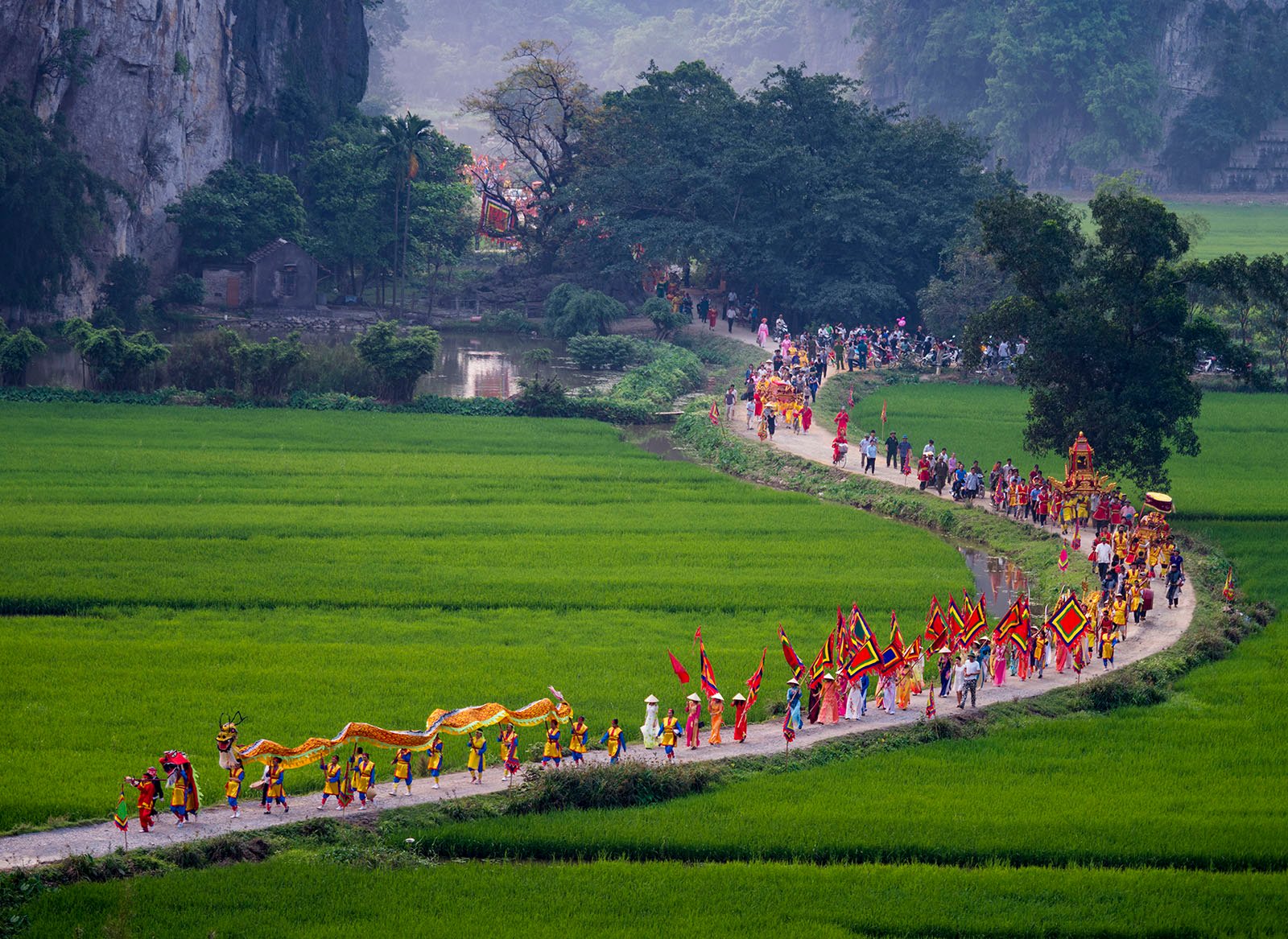
Address: Van Lam Village, Ninh Hai Commune, Hoa Lu District, Ninh Binh Province
Festival time: From March 14 to 17 of the lunar calendar every year
As one of the spiritual tourist destinations in Ninh Binh that attracts a large number of visitors, Thai Vi Temple bears the historical imprint of the Tran Dynasty. The temple was built to honor the four Tran Kings - Tran Thai Tong, Tran Thanh Tong, Tran Nhan Tong, Tran Anh Tong - and Queen Mother Thuan Thien, to remember their great contributions in the resistance war against the Yuan-Mongol army and to protect Dai Viet territory.
Located on the foundation of the ancient Vu Lam palace, Thai Vi Temple possesses a unique architecture in the style of "Inner public, outer private". In front of the temple is a crystal clear jade well, creating a sacred and peaceful space. The impressive highlight in the campus is the two-storey, eight-roofed bell tower made entirely of rare ironwood. Inside hangs an ancient bronze bell, cast in the 19th year of Chinh Hoa (1689), which is a testament to the temple's rich history and unique cultural value.
5. Tran Temple (Noi Lam Temple)
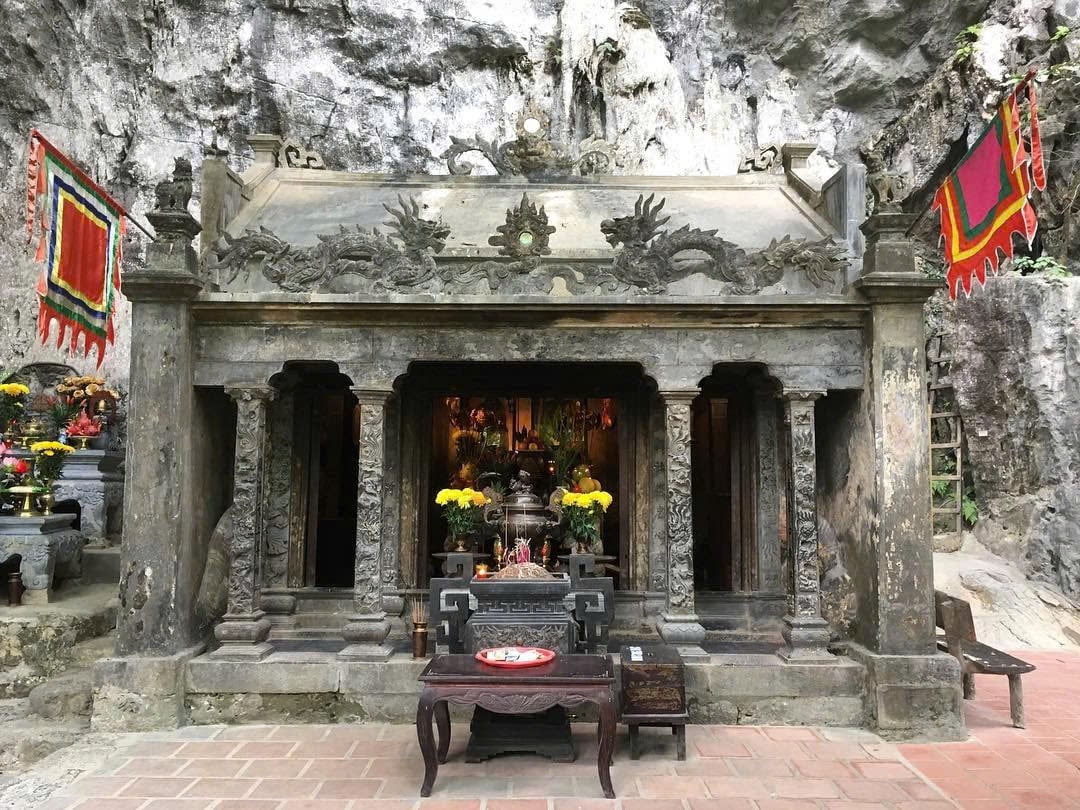
Address: Ninh Xuan Commune, Hoa Lu District, Ninh Binh Province
Located in the southern position of the ancient capital Hoa Lu, Tran Temple is a spiritual tourist destination in Ninh Binh that stands out for its historical and religious values. The temple worships Than Quy Minh - one of the three sacred gods worshiped by the people since the Hung King period, along with Duc Thanh Tan Vien and Duc Thanh Cao Son. Than Quy Minh was once conferred the title of "superior god", with great merit in protecting the borders of the Southern country in ancient times, so he was highly respected by feudal dynasties.
Tran Temple is located on a high mountain, amidst the picturesque landscape of Trang An scenic area, known as "Ha Long Bay on land". The original construction was built during the reign of King Dinh Tien Hoang to guard the four directions according to ancient feng shui concepts. Later, during the Tran Dynasty, the temple was solidly restored with a system of stone pillars intricately carved with the images of the four sacred animals: dragon, unicorn, turtle, phoenix - symbols of power and sacredness. With its majestic landscape and ancient architecture, this place is not only a historical relic of Ninh Binh but also an ideal destination for those who want to return to their cultural roots, explore folk beliefs and immerse themselves in the unique traditional festivals of the ancient capital.
6. Saint Nguyen Temple
Address: Gia Thang Commune, Gia Tien Commune, Gia Vien District, Ninh Binh Province
The Saint Nguyen Temple worships Ly Dynasty National Master Nguyen Minh Khong (or Ly Quoc Su), a high-ranking monk who held the position of head of the Ly Dynasty court in Vietnamese history due to his many contributions in curing the illness of King Ly and the people. The temple was built on the foundation of Vien Quang Pagoda built by Nguyen Minh Khong himself in 1121. After his death, people worshiped him here. The Saint Nguyen Temple is located in the North of Hoa Lu Citadel, one of the four ancient Hoa Lu towns.
In addition to its historical value, the temple is also recognized for its unique architectural and artistic value due to its sophisticated carvings and sculptures. Currently, the temple still preserves many ancient artifacts. In front of the incense burning hall are two stone squirrels from the early Le Dynasty, in the hall there are two drums from the Ly - Tran Dynasty, which are very rare, the entire altar of the Nguyen Dynasty,... The Nguyen Temple was ranked as a National Architectural and Artistic Monument in 1989.
The Saint Nguyen Temple worships Ly Dynasty National Master Nguyen Minh Khong (or Ly Quoc Su), a high-ranking monk who held the position of head of the Ly Dynasty court in Vietnamese history due to his many contributions in curing the illness of King Ly and the people. The temple was built on the foundation of Vien Quang Pagoda built by Nguyen Minh Khong himself in 1121. After his death, people worshiped him here. The Saint Nguyen Temple is located in the North of Hoa Lu Citadel, one of the four ancient Hoa Lu towns.
In addition to its historical value, the temple is also recognized for its unique architectural and artistic value due to its sophisticated carvings and sculptures. Currently, the temple still preserves many ancient artifacts. In front of the incense burning hall are two stone squirrels from the early Le Dynasty, in the hall there are two drums from the Ly - Tran Dynasty, which are very rare, the entire altar of the Nguyen Dynasty,... The Nguyen Temple was ranked as a National Architectural and Artistic Monument in 1989.
7. Nguyen Cong Tru Temple
Address: Quang Thien Commune, Kim Son District, Ninh Binh Province
Nguyen Cong Tru Temple is a prominent spiritual tourist destination in Ninh Binh, associated with the name of a famous person in the history of the nation. The temple was built during his lifetime, based on a three-room house in Lac Thien hamlet - where he lived and worked when he was assigned to develop the Kim Son land. In 1852, the local people renovated the house into a living temple - called Sinh Tu - and held a birthday celebration for him every year. After Nguyen Cong Tru passed away, the people built an additional Tien Duong room to worship him, and the old house was used as the main palace. Since then, the temple was renamed Truy Tu Tu - expressing the deep gratitude of later generations. In 1992, the project was ranked as a National Historical and Cultural Relic.
The temple has a Dinh (丁) architectural style, including a 5-room Front Hall and a 3-room Back Hall. On both sides of the Front Hall are a pair of large bronze pillars, inside are an incense table, a gong stand, a drum stand and three large inscriptions recording the respect of the Kim Son people for the talented Doanh Dien Su. The main room of the Back Hall is where the altar of Nguyen Cong Tru is located, highlighted by a white porcelain incense burner from the Tran Dynasty, carved with the image of two dragons facing the moon - a rare antique with high historical value.
Nguyen Cong Tru Temple is a prominent spiritual tourist destination in Ninh Binh, associated with the name of a famous person in the history of the nation. The temple was built during his lifetime, based on a three-room house in Lac Thien hamlet - where he lived and worked when he was assigned to develop the Kim Son land. In 1852, the local people renovated the house into a living temple - called Sinh Tu - and held a birthday celebration for him every year. After Nguyen Cong Tru passed away, the people built an additional Tien Duong room to worship him, and the old house was used as the main palace. Since then, the temple was renamed Truy Tu Tu - expressing the deep gratitude of later generations. In 1992, the project was ranked as a National Historical and Cultural Relic.
The temple has a Dinh (丁) architectural style, including a 5-room Front Hall and a 3-room Back Hall. On both sides of the Front Hall are a pair of large bronze pillars, inside are an incense table, a gong stand, a drum stand and three large inscriptions recording the respect of the Kim Son people for the talented Doanh Dien Su. The main room of the Back Hall is where the altar of Nguyen Cong Tru is located, highlighted by a white porcelain incense burner from the Tran Dynasty, carved with the image of two dragons facing the moon - a rare antique with high historical value.
8. Cao Son Temple
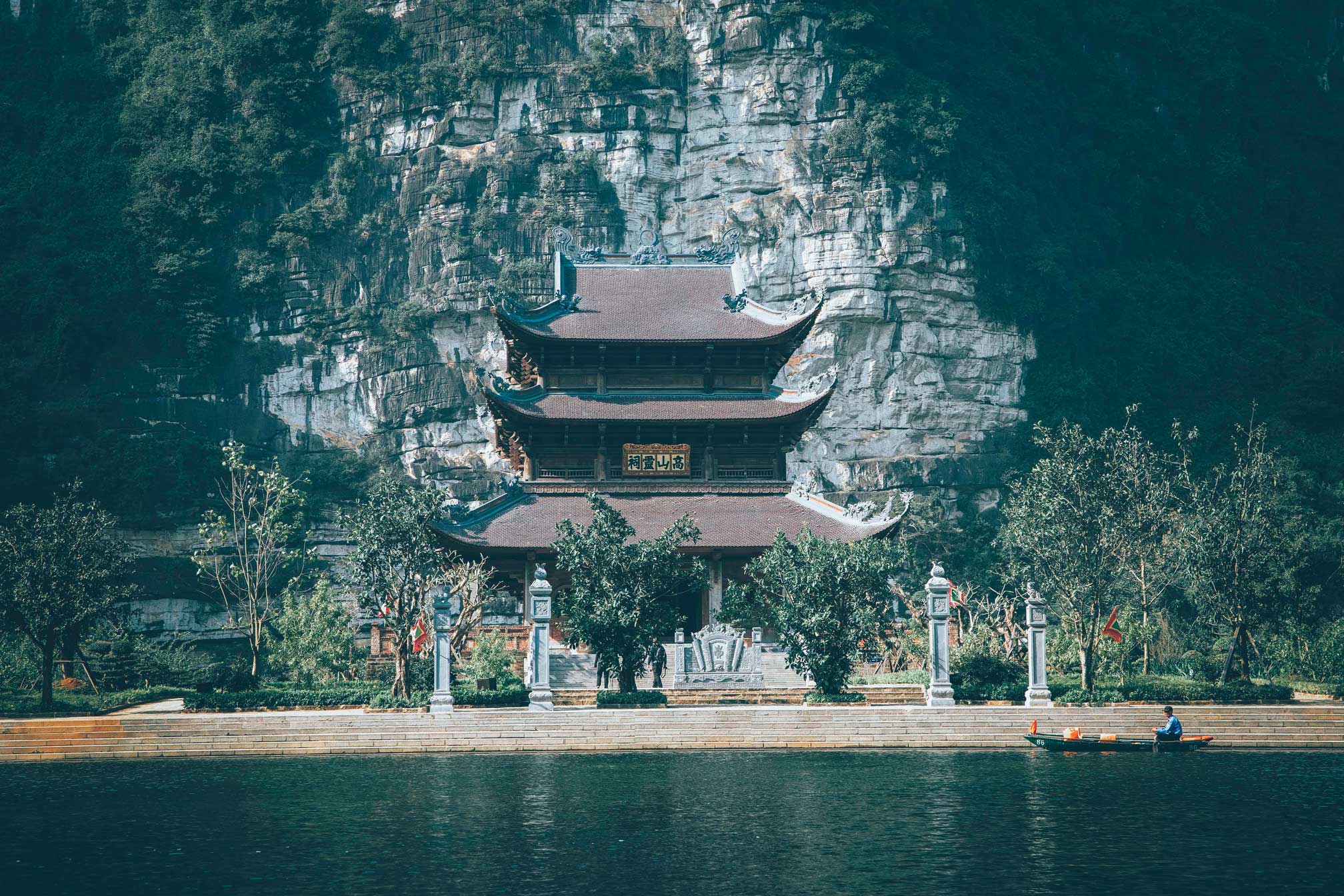
Address: Van Phu Commune, Nho Quan District, Ninh Binh Province
Cao Son Temple is one of the spiritual tourist destinations in Ninh Binh with a strong historical and cultural imprint. According to legend, Cao Son Dai Vuong was the 17th son of Lac Long Quan, who held the position of Lac Tuong Vu Lam. He not only taught people how to cultivate and live, but also helped them fight against invading forces. Because of his great contributions, King Dinh Tien Hoang built a temple on Dinh Mountain to guard the west of Hoa Lu capital.
Cao Son Temple, together with the temples of Than Thien Ton (East), Quy Minh Dai Vuong (South) and Duc Thanh Nguyen (North), form the system of "Hoa Lu Tu Tran" - four sacred temples protecting the ancient citadel. This is an ideal destination for tourists who love history, beliefs and want to learn about the unique folk culture of the ancient capital.
9. Non Nuoc Pagoda
Address: Thanh Binh Ward, Ninh Binh City
Nestled at the foot of Non Nuoc Mountain, beside the poetic Day River and near the mouth of the Van River, Non Nuoc Pagoda is a spiritual tourist destination in Ninh Binh that attracts many visitors from near and far. This place is not only an ancient Ninh Binh pagoda with a long history, but also an ideal stopover for those who love the peaceful, quiet beauty of the Northern countryside.
The pagoda was built during the Ly Dynasty, and was restored and worshiped Buddha during the Tran Dynasty. Through many historical ups and downs, the pagoda still retains its ancient and sacred architecture, and is an indispensable destination in the journey to explore Ninh Binh. In addition to the name Non Nuoc Pagoda, this place is also known as Duc Thuy Son - associated with a long-standing cultural and spiritual tradition.
With two main gates – the north and the southeast – the pagoda welcomes visitors from all over. In particular, the southeast gate overlooking the Day River is also where people often release carp on the day of the Kitchen Gods. The pagoda is open all year round, but Tet is still the ideal time to visit the pagoda at the beginning of the year, feeling the cold and solemn atmosphere amidst the peaceful space and beautiful mountains and rivers.
Nestled at the foot of Non Nuoc Mountain, beside the poetic Day River and near the mouth of the Van River, Non Nuoc Pagoda is a spiritual tourist destination in Ninh Binh that attracts many visitors from near and far. This place is not only an ancient Ninh Binh pagoda with a long history, but also an ideal stopover for those who love the peaceful, quiet beauty of the Northern countryside.
The pagoda was built during the Ly Dynasty, and was restored and worshiped Buddha during the Tran Dynasty. Through many historical ups and downs, the pagoda still retains its ancient and sacred architecture, and is an indispensable destination in the journey to explore Ninh Binh. In addition to the name Non Nuoc Pagoda, this place is also known as Duc Thuy Son - associated with a long-standing cultural and spiritual tradition.
With two main gates – the north and the southeast – the pagoda welcomes visitors from all over. In particular, the southeast gate overlooking the Day River is also where people often release carp on the day of the Kitchen Gods. The pagoda is open all year round, but Tet is still the ideal time to visit the pagoda at the beginning of the year, feeling the cold and solemn atmosphere amidst the peaceful space and beautiful mountains and rivers.
10. Phat Diem Stone Church
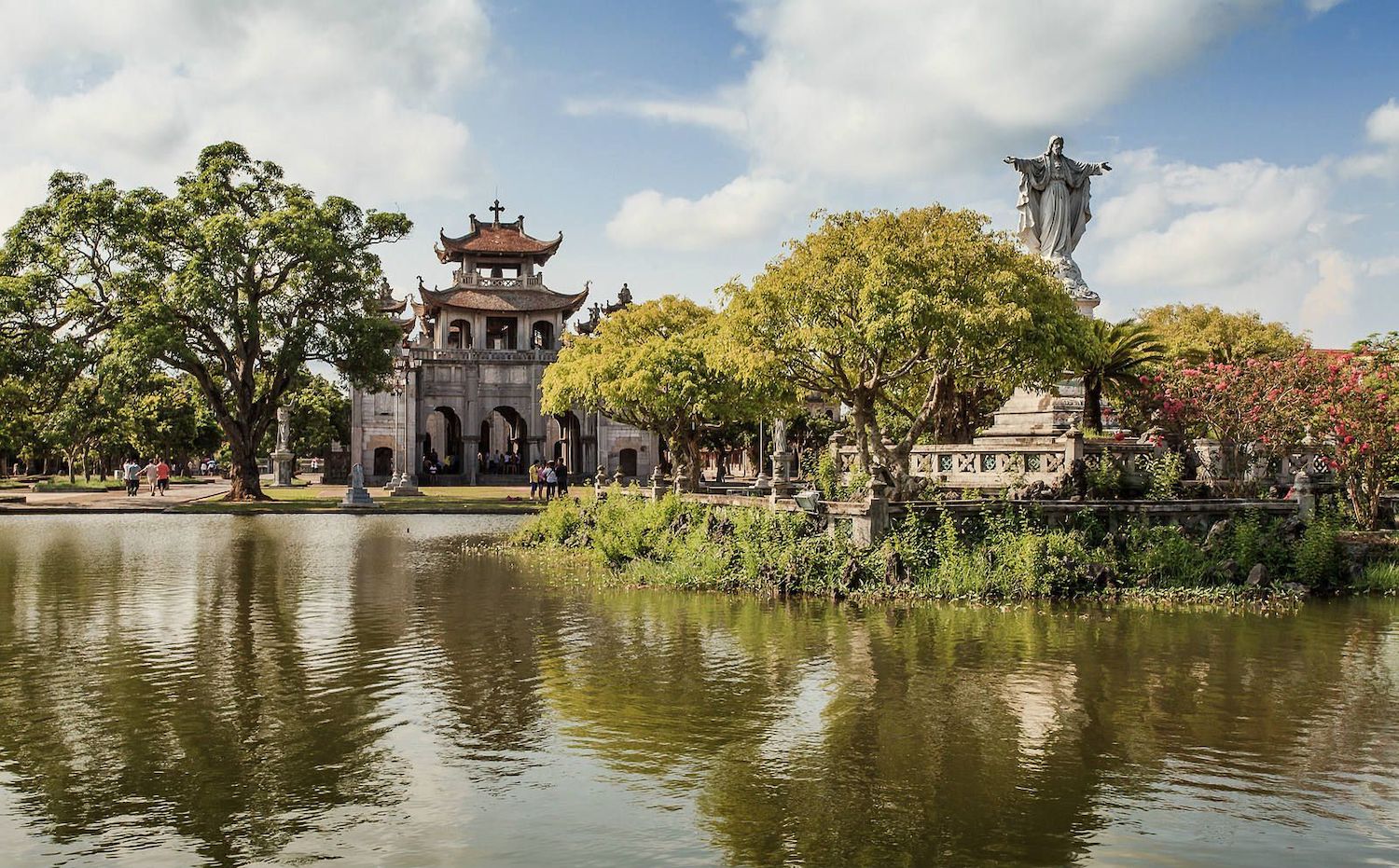
Address: Phat Diem Town, Kim Son District, Ninh Binh Province
Main festival: Christmas, held on December 24 and 25 every year
Phat Diem Stone Church, also known as Phat Diem Cathedral, is one of the most unique religious architectural works in Vietnam. Considered the "Catholic capital" of the country, this place stands out with its unique architecture that harmoniously combines the style of Asian temples and Western Gothic architecture. This is an ideal destination for those who are passionate about exploring cultural heritage, especially sophisticated stone sculptures.
The church complex includes the main church, Phuong Dinh, a lake, four small churches and especially the stone church - which is considered a "precious gem" in the heart of Kim Son. The project was built from 1875 and completed in 1898, and in 1988 was ranked as a National Historical and Cultural Relic.
Not only does it have profound religious value for the Catholic community, Phat Diem Stone Church is also a spiritual tourist destination in Ninh Binh that attracts thousands of visitors every year. This is an ideal stopover for visitors who want to learn about religious culture, admire ancient religious architecture, or simply enjoy the peaceful space in the heart of the ancient capital.
Not only is it a stopover for pilgrims, Ninh Binh spiritual tourist destinations are also places that preserve the precious architectural, historical and cultural values of the nation. Each construction has its own story, giving visitors a sense of serenity and a deep connection with their roots. If you have the opportunity to visit the ancient capital, do not forget to take the time to admire, feel and preserve the peaceful moments in this sacred place of beautiful mountains and rivers.
For more information about the program, please contact:
VIETRAVEL
190 Pasteur, Vo Thi Sau Ward, District 3, HCMC
Tel: (028) 3822 8898 - Hotline: 1800 646 888
Fanpage: https://www.facebook.com/vietravel
Website: www.travel.com.vn
Source of article: Collected and compiled
@traveltips #traveltips
Source: https://www.vietravel.com/vn/am-thuc-kham-pha/dia-diem-du-lich-tam-linh-o-ninh-binh-v16966.aspx










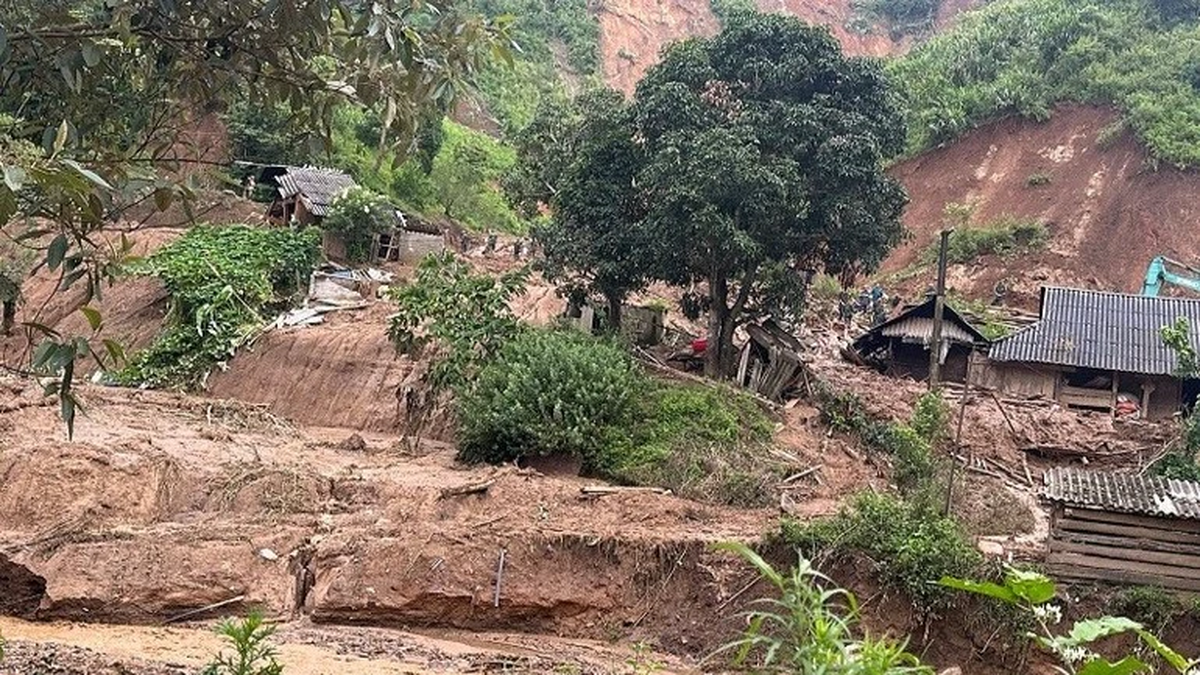























































































Comment (0)